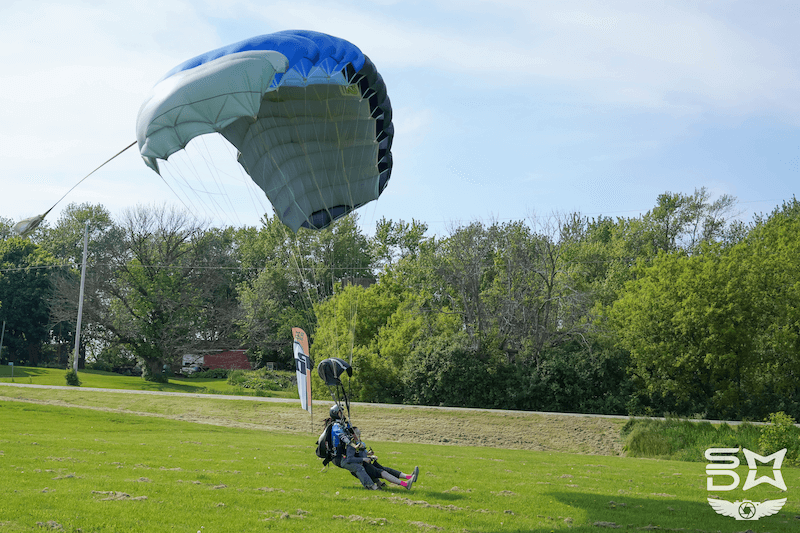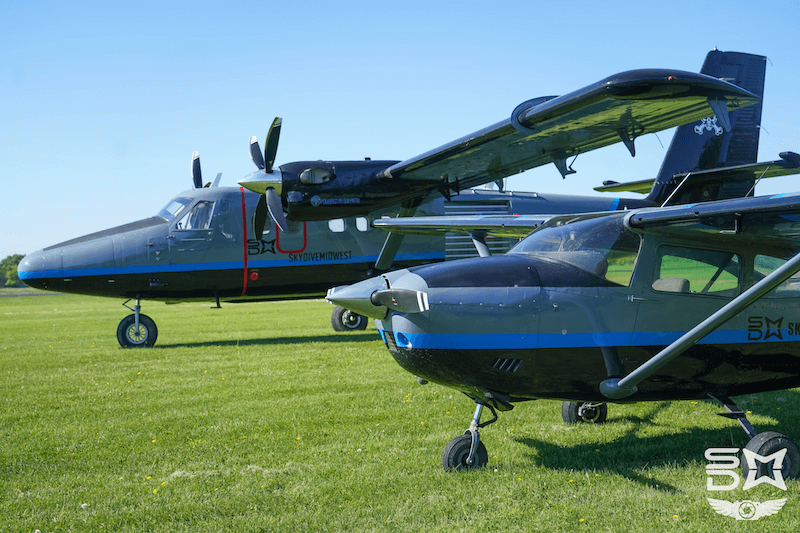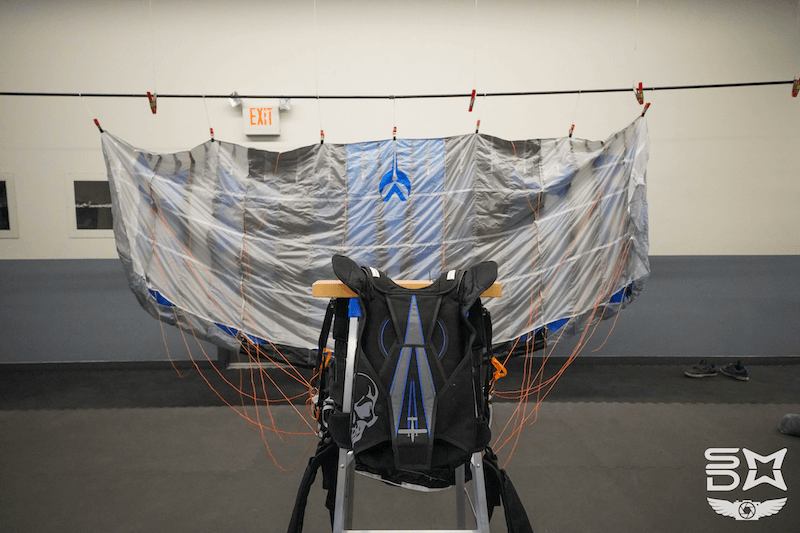Is Skydiving Safe:
Five Things to know before you Jump
If you’re thinking about skydiving, you’re probably wondering, is skydiving safe? The answer is: Tandem skydiving is one of the safest ways to skydive. However, skydiving is an extreme sport. Like any extreme sport, there are inherent risks. That’s why it’s crucial to work with skydiving centers that understand how to mitigate these risks and take the proper precautions to make your safety a top priority.
Do your homework before you jump, and make sure your skydiving center is doing everything possible to conduct the safest experience possible.
Here are 5 things you should know before you jump.
USPA Skydiving Center
Your skydive instructor’s experience is key. At Skydive Midwest, we recommend only jumping at skydiving centers that are members of the United States Parachute Association (USPA). How do you know the skydiving center is a member of the USPA? Just ask!
If you jump at a USPA skydiving center, your instructor should also be a USPA rated instructor. This certification means your instructor is trained to the specifications required by the USPA, the FAA (Federal Aviation Administration), and the manufacturer of the tandem parachute system you will be using.
The USPA has rigid requirements for obtaining and maintaining certification and enforces punishment, including revoking the instructor’s license or certification if safety violations occur. The strict regulations on tandem operations help make tandem skydiving one of the safest ways to experience the sport.
USPA Rated Tandem Instructor
Becoming a USPA rated Tandem Instructor demands rigorous skill training. A candidate must attend and pass a challenging Tandem Instructor Rating course. Before they can even participate in the course, they must have a minimum of 500 jumps, 3 years experience in the sport, and hold a USPA Coach Rating. They must also obtain an FAA Class 3 Medical certification to be deemed medically fit to become a Tandem Instructor. After all those requirements are met, they can attend the course. The Tandem Instructor Rating course includes rigorous ground/classroom training, a written test, and many training jumps with other licensed skydivers. Finally, they can do evaluation jumps with a USPA Tandem Instructor Evaluator to earn their rating.
Safety Days
The USPA strongly encourages skydiving centers to host a Safety Day at least once a year. These Safety Day events offer seminars and presentations to review various safety topics to all jumpers, including pilots, tandem instructors, videographers, sport or “fun” jumpers, and students in the licensing program.
S&TA
Additionally, every skydiving center should have an appointed Safety and Training Advisor (S&TA) who enforces all FAA and USPA regulations for all skydivers, provides advice and training, verifies rating renewal requirements, issues license tests, and reports any safety violations to the USPA.
Pre-Skydive Training
Training each tandem student is also a critical piece to safer skydiving. Before your skydive, you should participate in a brief training class. The instructor should go over some information about the equipment you’ll use, exiting the aircraft, freefall body position, and proper landing procedure.
Proper Landing Position
The most important part of this training is proper landing position. A common injury in tandem skydiving is a sprained ankle due to the tandem student’s incorrect landing position.

Maintenance
Though you’re eventually going to be jumping out, the plane needs to get off the ground and up to altitude safely. If the skydiving center has mechanics on staff or on-site, you can bet they take airplane safety seriously! An Airframe and Powerplant Mechanic (A&P) or an A&P with Inspection Authorization (IA) can address any issues, big or small, immediately. Skydiving centers without an IA or A&P on-site often have to wait for a convenient time or shut down until they are able to get the plane to a mechanic or bring one in to service it.

FAA Standards
All aircraft must be maintained to FAA standards. A skydiving center should have a good relationship with the local Flight Standards District Office (FSDO). The FSDO performs routine inspections of both the aircraft and the tandem equipment to ensure it is maintained to FAA standards.
Parachute Container Systems
There are many choices when it comes to skydiving equipment. We recommend SIGMA, manufactured by United Parachute Technologies, for tandem parachute container systems (the backpack part that your instructor wears). Not only is SIGMA comfortable, user-friendly, and offers state-of-the-art with superior safety features, United Parachute Technologies is a top manufacturer for many military operations. SIGMAs come equipped with a 360 square foot reserve parachute, your “back up” parachute. For additional safety, reserve parachutes must be pulled out, inspected, and repacked every 180 days by an FAA Certified Parachute Rigger.

Main Parachutes
At Skydive Midwest, we use TX2 “Main” parachutes manufactured by Icarus World as your primary parachute. TX2s tend to open gently, making your transition from 120mph to 25mph a bit less jarring. These parachutes are very responsive and easy to fly. They are beautifully engineered to have a lot of “flare” power and make the landing softer. Main parachutes are repacked after every jump by a highly trained parachute packer under the supervision of an FAA Certified Parachute Rigger.
Automatic Activation Devices
All tandem parachute systems are required to contain an AAD (Automatic Activation Device) that works as a backup deployment system in the event your instructor was unable to deploy the main parachute. At Skydive Midwest, we employ AADs manufactured by Vigil. These AADs monitor your speed and altitude throughout your jump. If you are traveling at freefall speeds when you reach a certain altitude, the device is designed to automatically deploy your reserve parachute without any action needed by you or your instructor. In the unlikely event your instructor loses consciousness, an AAD is constructed to deploy your parachute.
A Weather Hold
Sometimes we can’t skydive due to the weather. We know this is a total drag. Rest assured, your instructor is just as bummed as you are when a decision is made by the S&TA to put the operation on “weather hold.” However, safety should be priority number one at any skydiving center. So, if you’re on hold it’s probably for good reason. There are two primary weather conditions that can cause a hold: high winds and very low or very dense cloud cover.

High Upper and Ground Winds
High “upper” winds (the wind at 14,500ft when we exit the plane) can cause unpredictable or extreme “drift” in freefall, making it difficult to accurately land at the designated landing area at the airport. Landing off of the airport can mean navigating around roads, powerlines, trees, homes, and other hazards. High “ground” winds also make it difficult to land at the airport. The ground winds can be so strong they can cause your parachute to be unable to make the forward progression and may even push your parachute backward! Obviously, backward isn’t the safest way to land.
Clouds
Clouds can be beautiful and we LOVE seeing the formations in freefall and under the canopy. However, we must avoid flying into clouds because it restricts visibility. We have to be able to see the ground in order to land safely. We also need good visibility in order to avoid collisions with other jumpers or aircraft.
What is Skydive Midwest's Safety Record?
We have one of the absolute best safety records in the business.
We have an Expert S&TA on-site who is also a Tandem Instructor Evaluator.
We put on multiple training and retraining events throughout the year.
We provide thorough training with each tandem student.
We have A&Ps and an IA on-site for aircraft maintenance.
We have a stellar relationship with our local FSDO.
We buy only the best skydiving equipment on the market.
We meticulously maintain our equipment by our on-site FAA Certified Parachute Rigger.
We go the extra mile to mitigate the inherent risks of skydiving.
Do your homework before your jump and don’t be afraid to ask questions. A reputable skydiving center should have no problem answering them. When you jump with us, skydiving is as safe as it really can be.

